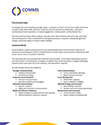CollectivNews
Welcome to a monthly round-up of information relevant
to comms professionals and everyone interested in the fractional model.
February 2025

AI In The Workplace: Unlocking Its Full Potential with Bold Leadership
Artificial intelligence (AI) is rapidly transforming workplaces, promising enhanced productivity and innovation. Despite widespread investment, however, only 1% of organizations consider themselves mature in AI adoption, according to a recent McKinsey report.
Employees are ready, but are their leaders?
AI Adoption: The Employee vs. Leadership Gap
The McKinsey report highlights a surprising reality: employees are more prepared for AI adoption than leaders assume. Many workers already leverage AI tools and believe that AI could automate up to 30% of their tasks in the near future. They are also eager to develop AI-related skills.
In contrast, leadership hesitancy — whether due to uncertainty about AI’s role, concerns about job displacement, or a lack of clear AI strategies — slows down implementation. This leadership gap creates a bottleneck that prevents organizations from fully harnessing AI’s potential.
How Leaders Can Accelerate AI Maturity
The report cites three key actions leaders must take to bridge this gap and move beyond experimentation:
1. Establish Bold AI Objectives — Set clear objectives and strategies, embedding AI in workflows to drive efficiency, decision-making, and innovation.
2. Invest in AI Training and Upskilling/Reskilling — AI is only as effective as the workforce using it. Companies must provide ongoing education to help employees build confidence and competence in AI-powered tools.
3. Prioritize AI Safety and Trust — Concerns around AI bias, security, and reliability must be addressed with strong governance and ethical frameworks to ensure responsible AI deployment.
Final Thoughts: A Leadership Opportunity
AI is already reshaping how we work, and employees are ready. The challenge lies in leadership’s ability to embrace it with confidence and purpose.
The good news? Employees trust business leaders to get it right. While they recognize AI’s potential to replace tasks, they also believe in their organizations’ ability to deploy it safely and ethically. In fact, 71% of employees trust their employers more than universities, large tech companies, or startups when it comes to responsible AI adoption.
This presents a significant opportunity for leaders who act decisively and ethically in AI adoption to not only drive productivity and innovation but also strengthen trust and engagement inside their organizations.
For a deeper dive into AI adoption strategies, read McKinsey’s full report: AI in the workplace: A report for 2025 | McKinsey

Welcoming Former Walmart and Boeing CCO Brian Besanceney as a Partner
We are thrilled to announce that Brian Besanceney, a storied communications leader with 25+ years leading comms for Fortune 50 companies, the White House, and global brands like Walmart, Disney, and Boeing has joined CommsCollectiv as a partner.
Brian is one of the most respected practitioners in the industry; his joining CommsCollectiv signals that the fractional model, proven in finance, marketing and HR, is not only viable in communications, but great a way for organizations of all sizes to access senior communications and corporate affairs expertise that might have otherwise been out of reach.
In this time of geopolitical risk and changing stakeholder expectations, it’s not only large multinational companies that are dealing with significant issues. Mid-cap companies, too, are finding themselves with large-cap problems, requiring different communications expertise.
Brian’s track record of leading communications through complex situations at some of the world’s most prominent companies adds another dimension to our partner team and value to our clients and talent. This is particularly valuable as our innovative model — offering flexibility without compromising senior communications and public affairs expertise — continues to take hold.
CommsCollectiv has experienced significant growth since its launch in November 2023, building a network of more than 200 senior communications executives able to flexibly provide strategic, and precisely tailored communications strategies across industries and specialities.

Media Relations is Dying and We Should Let It Go
By Dan Nestle
According to the Big Book of Conventional Comms Wisdom, the vast amount of time and money I spent over the last few decades on all the meetings, pitches, briefings, coordination, corrections, progress reports, and measurement acrobatics performed in the service of Media Relations should all have been worth it. Earned media placements are a typical KPI for our ilk, and securing interviews and bylines is a sure path to success.
But the undeniable fact is that our audiences are running away from traditional media in droves, and for a variety of reasons:
— An ever-expanding, fractured universe of media.
— Reporter and journalist turnover.
— Rise of independent media (writers, analysts, podcasters, and a growing number of “influencers” – YouTubers, TikTok-ers, Tweeters, and more).
— Americans’ trust in the media is at an all-time low according to a recent Gallup poll.
Without a doubt, we still need traditional Media Relations – particularly for public companies, highly regulated industries and overseas — but for the vast majority of businesses, from startups to small shops to mid-market and beyond, you don’t need the headache.
Earned media is an effective way to grow awareness, build and defend authority and reputation, inform and educate stakeholders, shape public narratives, attract talent, and accrue trust on the merits of our knowledge, opinions, offerings, products, and deeds. Earned media provides critical third-party validation and makes or breaks our credibility.
If we need non-affiliated people and organizations to agree that we’re the bee’s knees, and traditional Media Relations isn’t doing the job, then what will?
Earned Attention. Shifting to a broader attention-based approach that brings multiple forms and formats of earned content into account. Think about it:
Earned Attention reflects the current landscape.
Earned Attention is audience-centric.
Earned Attention is more adaptable to strategy.
Earned Attention subsumes Media Relations anyway.
Whether you share my soapbox or not, there’s no doubt that we have to evolve as a profession and accept that Media Relations today isn’t what it used to be. I’m anticipating a sea change in our profession, and I believe the Media Relations pedestal is collapsing.
How long will it take for brands, organizations, and agencies to move on? The proliferation of AI and technology-enhanced solutions tells me, not very long.
So it’s going to be up to us to effect change from within. And that will require building trust, putting the business first, and lots and lots of data.
Excerpted from the October 8, 2024, “Communications Trends from Trending Communicators Newsletter.” Read the full article on CommsCollectiv.com.


